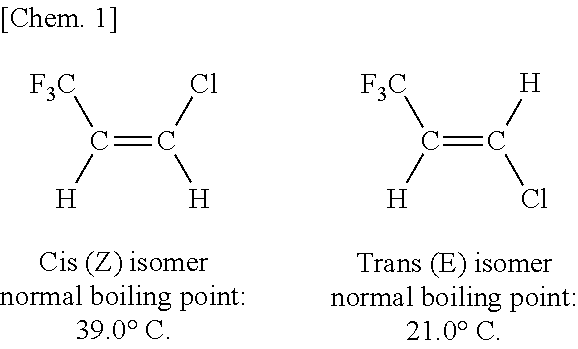Method of Purifying (Z)-1-Chloro-3,3,3-Trifluoropropene
a technology of trifluoropropene and z-chloro-3,3,3-trifluoropropene, which is applied in the field of purifying z-chloro-3,3,3-trifluoropropene, can solve the problem of difficult separation of 1-chloro-3,3,3-trifluoropropene from 1-chloro-1,3 and achieve the effect of easy distillation of z-chloro-3,3,3-trifluor
- Summary
- Abstract
- Description
- Claims
- Application Information
AI Technical Summary
Benefits of technology
Problems solved by technology
Method used
Image
Examples
example 1
[0067]A glass rectification column of 26 mm in column diameter, equipped with a vacuum jacket and having a theoretical plate number of 50, was packed with a stainless steel packing material (Heli Pack No. 2 manufactured by Tokyo Tokusyu Kanaami Co., Ltd.). A raw material containing 83.6% (Z)-1-chloro-3,3,3-trifluoropropene and 16.4% 1-chloro-1,3,3,3-tetrafluoropropane was fed into the rectification column at 81.0 g / h from through an inlet portion at the 40th plate from the top of the column, whereas 1,1-dichloro-3,3,3-trifluoropropane was fed into the rectification column at 801.0 g / h from through an inlet portion at the 10th plate from the top of the column. In this state, distillation of the raw material was performed under ordinary pressure at a reflux ratio of 5 and a bottom temperature of 70° C. A distillate was obtained at 68.1 g / h from the top of the column; and a bottom product was obtained at 813.9 g / h. The compositions of the raw material, distillate and bottom product are...
example 2
[0068]A glass rectification column of 26 mm in column diameter, equipped with a vacuum jacket and having a theoretical plate number of 33, was packed with a stainless steel packing material (Dixon Packing manufactured by Tokyo Tokusyu Kanaami Co., Ltd.). A raw material containing 82.6% (Z)-1-chloro-3,3,3-trifluoropropene and 17.4% 1-chloro-1,3,3,3-tetrafluoropropane was fed into the rectification column at 22.8 g / h from through an inlet portion at the 28th plate from the top of the column, whereas dimethyl carbonate was fed into the rectification column at 197.2 g / h from through an inlet portion the 10th plate from the top of the column. In this state, distillation of the raw material was performed under ordinary pressure at a reflux ratio of 5 and a bottom temperature of 91° C. A distillate was obtained at 18.5 g / h from the top of the column; and a bottom product was obtained at 201.5 g / h. The compositions of the raw material, distillate and bottom product are indicated in TABLE 3....
example 3
[0069]A glass rectification column of 26 mm in column diameter, equipped with a vacuum jacket and having a theoretical plate number of 50, was packed with a stainless steel packing material (Heli Pack No. 2 manufactured by Tokyo Tokusyu Kanaami Co., Ltd.). A raw material containing 82.6% (Z)-1-chloro-3,3,3-trifluoropropene and 17.4% 1-chloro-1,3,3,3-tetrafluoropropane was fed into the rectification column at 81.0 g / h from through an inlet portion at the 40th plate from the top of the column, whereas acetonitrile was fed into the rectification column at 797.9 g / h from through an inlet portion at the 10th plate from the top of the column. In this state, distillation of the raw material was performed under ordinary pressure at a reflux ratio of 5 and a bottom temperature of 82° C. A distillate was obtained at 64.1 g / h from the top of the column; and a bottom product was obtained at 814.8 g / h. The compositions of the raw material, distillate and bottom product are indicated in TABLE 4.
T...
PUM
| Property | Measurement | Unit |
|---|---|---|
| boiling point | aaaaa | aaaaa |
| mass % | aaaaa | aaaaa |
| temperature | aaaaa | aaaaa |
Abstract
Description
Claims
Application Information
 Login to View More
Login to View More - R&D
- Intellectual Property
- Life Sciences
- Materials
- Tech Scout
- Unparalleled Data Quality
- Higher Quality Content
- 60% Fewer Hallucinations
Browse by: Latest US Patents, China's latest patents, Technical Efficacy Thesaurus, Application Domain, Technology Topic, Popular Technical Reports.
© 2025 PatSnap. All rights reserved.Legal|Privacy policy|Modern Slavery Act Transparency Statement|Sitemap|About US| Contact US: help@patsnap.com



